All about Google Ads in 2023
In this guide, Brandfirm breaks down everything you need to know, in uncomplicated terms, about Google Ads in 2023. With this guide within reach, Google Ads is made simple.

After reading this article, you learned:
- How to get more traffic to your website with a Google Ads campaign
- How to set up a successful Google Ads campaign yourself
- What Google Ads can bring you and how you can determine the marketing budget
- All about the optimization techniques used by advanced Google Ads specialists
In this article
1. Introduction to Google Ads
What do we mean by Google Ads?
We're happy to break it down for you.
Google Ads is a Google advertising program that places your ad above or below the organic search results on Google's Search Engine Result Page (SERP).
This allows you to easily increase your brand awareness.

SERP is the page you see after typing a keyword in Google's search bar.
At the top, you'll first see several paid ads (Google Ads) followed by organic search results.
These are closed by another set of paid ads. Below, we explain why it's so beneficial to rank highly on this page.
You can also advertise on all other Google platforms, such as YouTube. You'll find more information about the different ad types in Chapter 3.
Why use Google Ads?
You now know that Google Ads can boost your position in Google's SERP. This is why a high ranking on this page is so important:
Customers often pick the first link they come across on Google.
Research shows that, on average, 31.7% of all clicks go to the number #1 position. Not a bad position to have, we think.
Research shows that if you move up even one position, you are already 30.8% more likely to get clicks to your webpage.
The page at the top of the SERP is ten times more likely to get a click than the page at the tenth position. So the higher your ranking on Google, the better.
Now you know why it's important to have a high position in Google's SERP, you also know why it's interesting to invest in Google Ads.
You can claim that top position overnight using Google Ads. Your webpage will appear above the pages with the best organic results.
With Search Engine Optimization (SEO), it takes months, if not years, to rank highly in organic search results.
Request our free Google Ads analysis
- Gain insight into opportunities for Google Ads
- This takes us at least 4 to 6 hours of work
2. Setting up a Google Ads campaign in 11 steps
This roadmap will show you exactly how to set up a successful campaign. But don't worry, we will go into more detail on ad types, different goals, and bidding strategies further down in this guide.
1. Go to https://ads.google.com/
2. Set up a Google Ads account by clicking on 'Start now'.
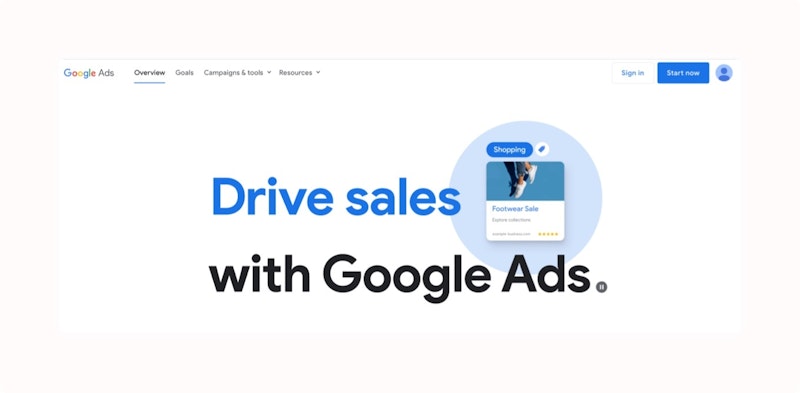
3. On the left side, look at Campaigns and click the blue (+) to create a new campaign.

4. Choose the ad type you want to use. Most business owners start with a search campaign. That's why we'll show you how to set up this type of campaign in this step-by-step plan.

5. Give your Google ad a goal. For example, select more traffic to your website if you want to attract more customers to your webpage.

6. Add the URL of the page you want more traffic on.
7. Give your campaign a clear name. Because you can set up several campaigns at once, it is important to be as specific as possible. For example: 'vintage designer bags'.
8. Choose between the search network or the Google Display Network. You can also choose both options. Is the campaign not running as you had hoped? Then you can always choose the other network in settings.

9. Choose the location of your ad. This can be a country, but also a specific city or region.
10. Choose the desired language of your ad.
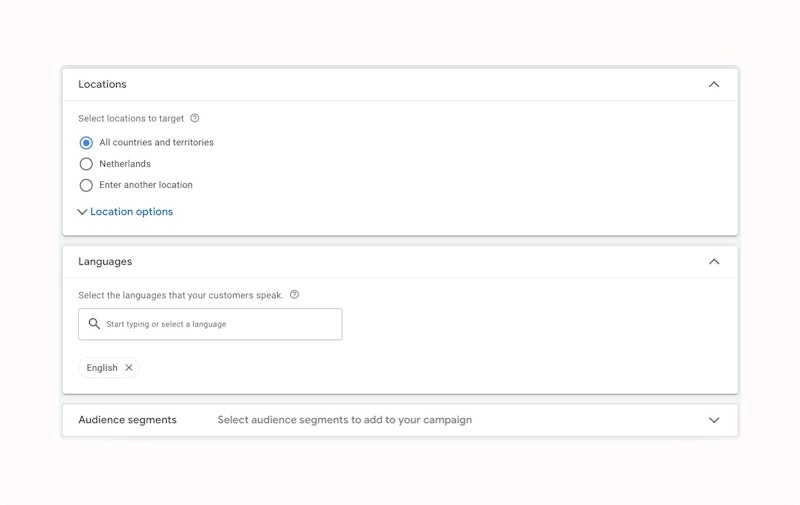
11. Time to choose a bidding strategy. There are several options here. If your goal is to get more traffic to your website, choose the bidding strategy: maximize clicks. This means the ad will drive as many visitors to your website as possible within your daily budget.
12. Determine your daily budget. To do this, divide the amount you normally spend on ads per month by the average number of days per month, which is about 30.4.
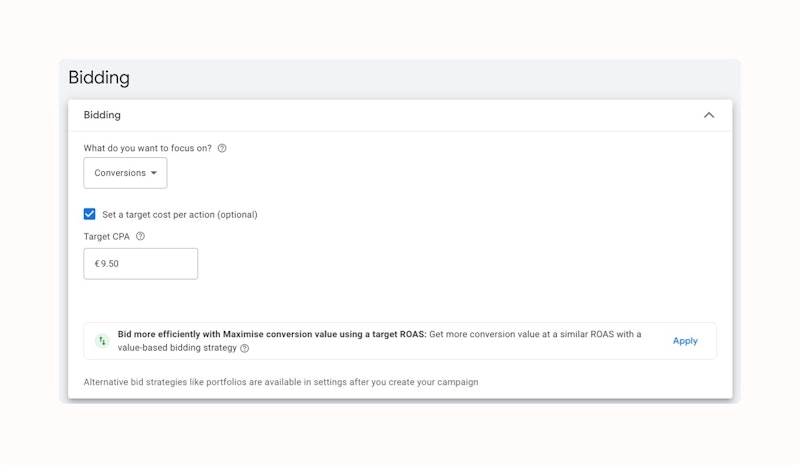
And there you have it: your campaign is ready.
Before you save your campaign, a pop-up screen will appear with extensions you can use.
This is not a must but is recommended as it gives the ad more space. You can also enter a start and end date if you’d like.
Left these blank? Then the campaign starts immediately and runs forever until you pause it yourself.
3. What is Google Ads?
When you use Google Ads, you pay every time a user clicks on your ad.
Yet the process is a little complicated.
Behind these ads is a complex bidding system that in part controls the price you have to pay per ad click. We'll explain this further in Chapter 5.
Good to know: when you use Google ads, you only advertise a specific product or a web page with information that customers are looking for.
This makes advertising on Google more attractive than TV or newspaper advertising.
Because people who see an ad on television or in a newspaper are not specifically looking for your product or service.
But with Google Ads, they are. A user is therefore much more likely to buy.
Google ads for keywords
Here's an example: A customer types in 'leather football' in the search bar and is shown several search results.
At the top and bottom of the page, they will find several ads, among which your ad is listed.
The big difference compared to 'normal' search results is that your page will have "ad" in bold letters.
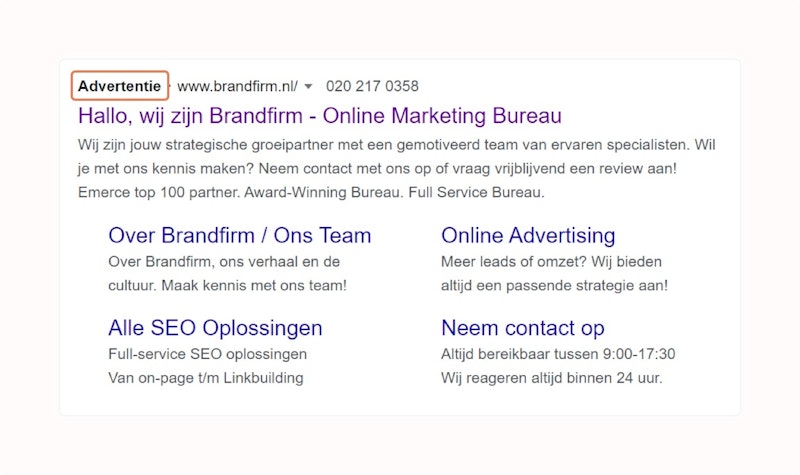
Working with Google Ads has many advantages, one of which is that research shows that about 24% of users click on an ad. Those users are potential customers who are looking for your product or service.
Google Adwords vs. Google Ads
Google renamed its advertising program ‘Google Ads’ in July 2018. Previously, it was called Adwords.
So don't get confused when these terms are used interchangeably. They mean the same thing.
Google Ads terminology
We use different terms in this guide.
We want everything to be easy to understand, so we'll explain the most important ones to you below:
- Google campaign: a collection of one or more ad groups. Say you have an online shop, you might have an umbrella campaign covering shoes, clothes, and accessories. You can run several campaigns at the same time.
- Ad groups: a collection of one or more ads that have the same keywords and bids.
- Ad: the actual ad that the customer sees in the Google SERP because the customer has entered keywords from your ad groups in the Google search bar.
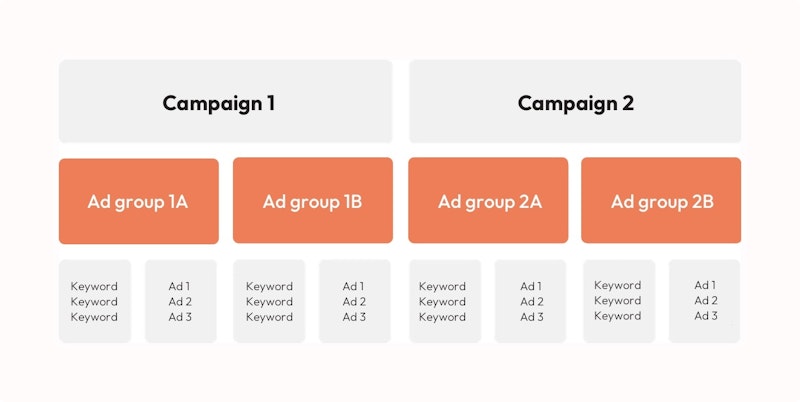
You can set up your Google ad to be very specific.
For example, you can specify in which area the ad should be shown.
We'll explain this in the next chapter.
Receive our newsletter
- +5,000 entrepreneurs preceded you. We share our knowledge for free.
4. How does Google Ads work?
Before you start using Google Ads, you should ideally have some understanding of how it works.
We have outlined this in a simple step-by-step plan.
Step 1: finding the right keywords
The advertiser needs to find the right keywords for a campaign.
With the right keywords, your ad will appear only to those users who are looking for what you offer.
Someone who's looking for a new bicycle will not click on an ad that has to do with winter coats.
This is how you find keywords that are relevant to your business:
- Use the Keyword Planner tool in your Google Ads account. You can find it by clicking on the tool icon in the upper right corner (Tools)
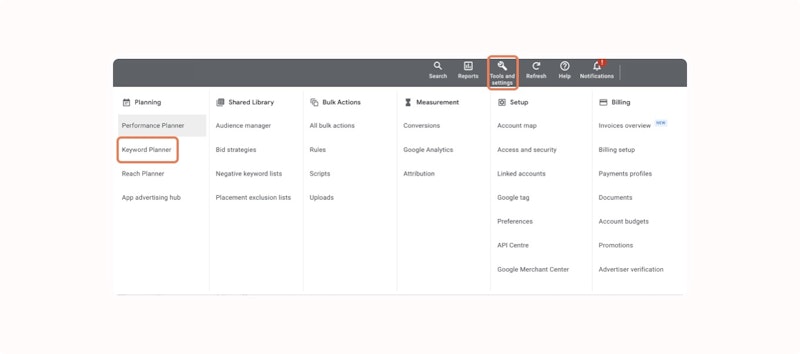
Look up the 'Discover new keywords' section and enter the URL of your website and enter a short description of the service or product you offer
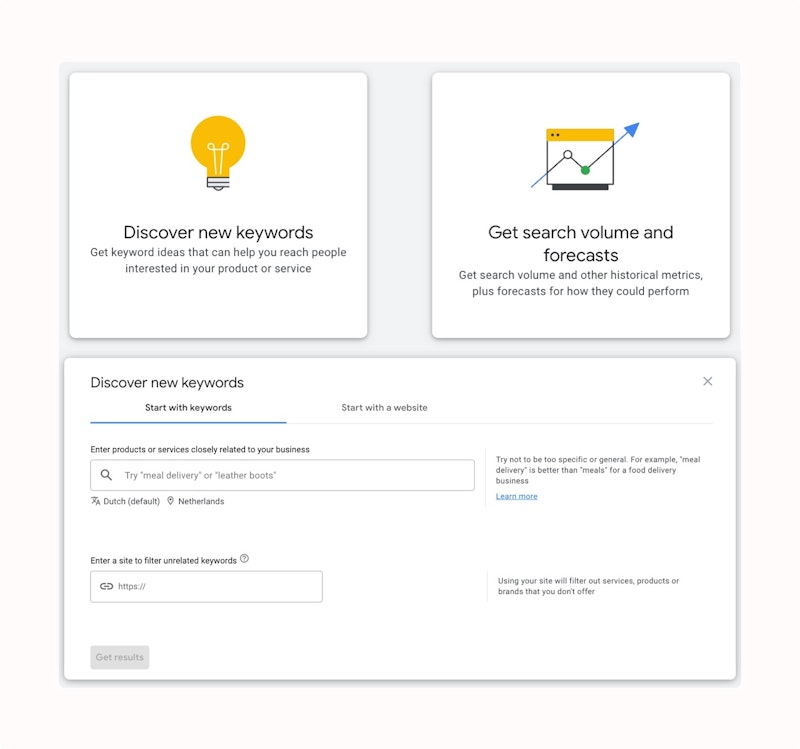
- Click enter (or Get results) and a table of related keywords will appear at the top of the page
- Click on the 'open box' to add a keyword to an ad group. This results in a collection of keywords that matches a particular product or service. For example: 'leather football', 'leather balls', and 'football leather'
Give this group of keywords a suitable name and save it to your account

When a customer types in the words 'leather football' into the search bar on Google, the keywords you collected a minute ago ensure that your ad will be shown to this customer.
Targeting keywords can work in four different ways:
- Exact match: this means that your page comes up when the exact keyword or a keyword very similar to it, because it has the same meaning, is typed into the search bar. Your ad will also come up when the keyword contains a spelling mistake. To choose an exact match, place the keyword between [ and ]
- Phrase match: Search results are shown that match a certain phrase. Your ad will not be shown if another word is added in the middle of a phrase. To choose a phrase match, put the phrase between " and "
- Broad match: Your page will also show up for keywords related to the keyword you chose for an ad. As well as for misspellings and synonyms. The advantage: great reach. Downside: you have little control over the keywords for which your page appears.
- Broad modified match: Works the same as a broad match, but the keyword you entered must be in the search query. To choose broad match modified, add a + to the keyword. Good to know: this way of targeting keywords is no longer supported by Google in the near future. So after this timeframe, this way of targeting keywords will no longer be relevant.
Step 2: creating text ads
Now that you've determined your keywords, it's time to create a good text ad. You can only do this after you've set up a campaign. It's important that the keywords match the ad.
Here's how to create an ad through Google Ads::
- Enter the URL of the landing page you want to send your new customer to
- Write the first headline, which is the header people see first when they land on Google's SERP. Make sure the title is related to the keywords in the ad group and make the sentence appealing enough so that potential customers are compelled to click on it. For example: buy a leather football
- Write the second headline, which is the piece of text after the hyphen in the header. Here you can say something about your service, for example: '- Free shipping from €50'.
- Write the third headline, this is for so-called ETA ads (Expanded Text Ads). Add a call to action. For example: '- View the offer'
- Adjust the URL to be seen on the SERP. This link gives the customer additional information about the page they'll land on once they click on the Google ad. For example: buy-leather-football
- Write the description. In it, you share more about your company and why the customer should really come to you for a particular service or product. Our tip: keep the text simple by focusing on one message
- There is also an option for a second description. This is an opportunity to provide additional information in 90 characters. This could be a short summary, such as: Wide offer * Low prices * Fast service
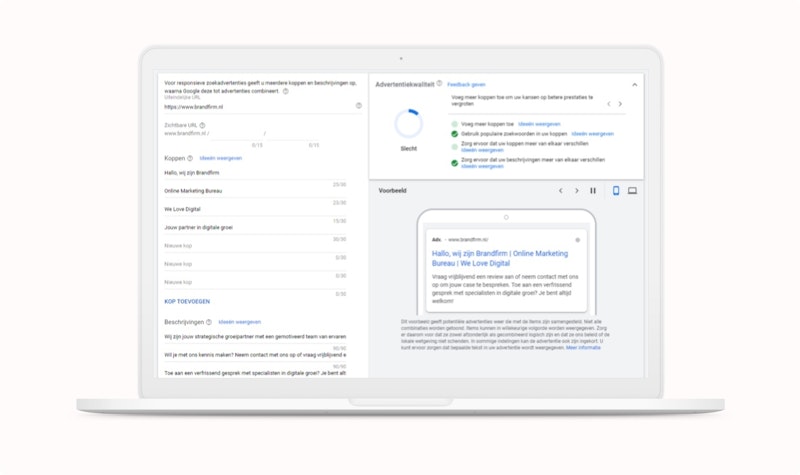
Step 3: targeting the ad
An important step for a successful ad is good targeting. After all, you want your dream customer to see the ad and make a purchase. Google Ads helps with this. You can specify the following things when creating a Google ad:
- Demographics: select locations, age groups, genders, and device types of interest to your business. Are you a carpenter in Leeuwarden? Then it probably doesn’t make sense to advertise in the Randstad. If you offer your services all over the country - because you work online - then choose the Netherlands as your region. Your ad will be shown throughout the country.
- In-market: your ad appears to users who are looking for similar products/services to those you offer.
- Remarketing: targets users who have already clicked on your ad before. This group is already interested, so they are more likely to buy from you.
- Select by topic: your ad appears on multiple pages with a specific topic at once. This is only possible on Google's Display Network
Step 4: bidding in the Auction and determining the Quality Score
You are not the only business owner using Google Ads.
To this end, Google created a system that determines the cost of your ad.
Quality score
The quality score of your ad is determined based on the following factors:
1. The ad relevance. For example: does the keyword appear in the Google ad?
2. The expected click rate. For example, does the ad contain enough call-to-actions inviting people to click on it?
3. The destination page experience. Make sure you set the right landing page for your ad.
A score of 1 is the lowest and 10 is the highest, and the higher the score the better your ad is.
Google's bidding system
You pay for a Google ad per click.
Just how high the fee per click is, however, varies from campaign to campaign.
It depends, among other things, on the quality score we previously explained, but also depends in part on a bidding system.
On popular keywords, for instance, there is much more competition from other advertisers.
After all, more people are typing in 'football', than 'leather football blue'.
The Auction: how it works
First off, you place a bid.
This is the maximum you are willing to pay per click.
The ad's quality score and the competitors' bids determine what you will actually pay per click.
So you may end up paying less for an ad. After all, Google wants users to find what they are looking for. A good quality score is rewarded with a discount on the price per click of up to 30%.
Good to remember: if you bid €1 and the second bidder bid €0.50, you pay (without taking the quality score into account) €0.51. So you always pay €0.01 more than the bidder below you.
At the moment, there are handy bidding strategies that take this work off your hands. We will describe this in more detail in chapter five.
Day budget vs. a bid
The daily budget differs from the bid you place in the bidding system.
With the daily budget, you determine how much you want to spend daily on a specific campaign.
A bid (also called CPC) is the maximum amount you want to pay per click.
Let's take an example:
Suppose your daily budget for a campaign is €17. You can show ads that fall within this campaign for that amount. To simplify things, this example assumes that there is only one ad included In this campaign. If this particular ad ends up costing €0.08 per click, you know that once you have received about 212 clicks in one day, your daily budget has run out. That means you will have to wait until the next day before this ad can be shown again.
Something to keep in mind: Google has the freedom to go 20% over your daily budget when they see that the ad is being heavily sought after on a particular day. However, this is always leveled out throughout the rest of the month, so your monthly total will always be the same. If you perform very well on day A, then there is a chance that on day B you will have to cut back a bit on your budget and ads.
Hopefully, everything has made sense so far.
In the next chapter, we will tell you more about the different ad types available in Google Ads.
Request our free Google Ads analysis
- A free analysis worth 4 to 6 hours of work
- 87% of the companies we analyze miss out on sales
5. What ad types are there?
In the previous chapter, we explained how to write a good text ad, but there are more ad types available on Google Ads.
This sounds complicated but is actually very convenient for business owners.
It allows you to find an ad type that best suits your business and the products or services you offer.
Which types are available depends on which campaign type you chose.
Paid search results vs. Google's other advertising options
Earlier, we showed you what a paid search results campaign looks like.
Your ad will show up as a paid search result in Google's SERP.
But Google has much more up its sleeve.
For instance, you can also choose Shopping, Video, or App campaigns, as well as a campaign via the Google Display Network, which is very popular among business owners.
Types of ads
Naast de tekstadvertentie waar je inmiddels mee uit de voeten kunt, zijn er nog meer type advertenties.
Besides text ads, which you are now familiar with, there are other types of ads. Below a brief overview:
- Text ads: for more information, see Chapter 3

- Image ads: this Google ad lets you visually promote your service or product. These can be static images or moving images (GIFs)
- Display ads: Through Google's Display Network, an ad for a particular product can pop up on over a million different websites. This allows you to easily increase brand awareness. You can do this using text, image, or video ads. Which websites you want to advertise on is entirely up to you. You can also start campaigns with both paid search results and Display ads.

- App ads: you can use this ad to promote your company's app. You can send customers a link to their provider's app store, for example, where they can download your app.
- Video ads: you can advertise using a flashy video. You can do this on YouTube (a Google partner), for example, or via the Google Display Network
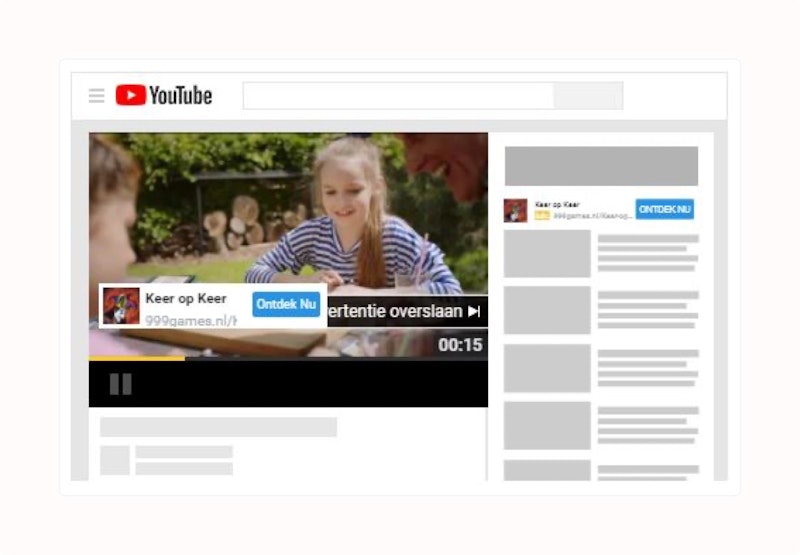
- Product shopping ads: as soon as a customer searches for a product on Google (e.g. 'leather football'), a row of promoted products appears at the top of the SERP with a price and link to the relevant online store (like yours!)
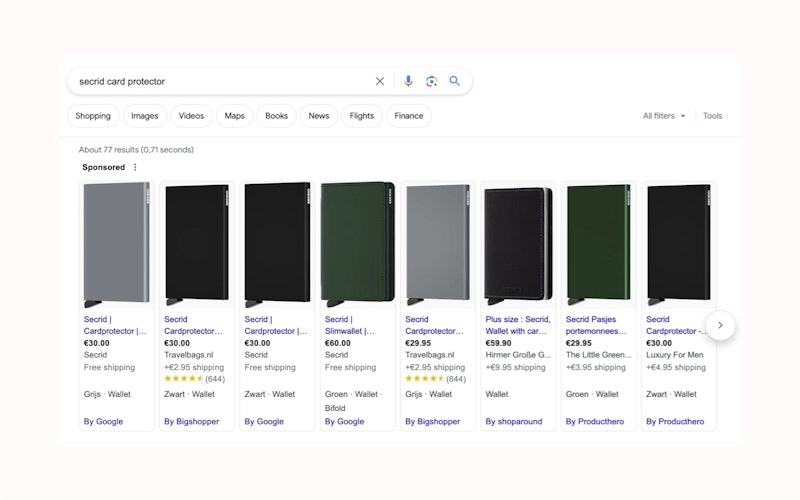
- Showcase shopping ads: as soon as a customer is interested in your product and clicks on it, a pop-up with additional information appears. This shows related products from your online store.
- Call-only ads: as a business owner, do you want to increase your contact with new customers? With this ad, you encourage potential customers to call you. Clicking on this ad will immediately place a call to the linked number. Easy for you and the customer.
Now let’s move on to the different bidding strategies available in Google Ads.
These are crucial and make working with Google Ads a lot easier.
6. Bidding strategies
In Chapter 3, we took a look at Google's Auction.
There are currently eight automatic bidding strategies that make the bidding process a lot easier.
In the previously listed 11-step plan to set up a Google Ads campaign, you learned that you can choose from several bidding options while creating a campaign.
To see which bidding option is best suited to your ad and business, we'll take a look at all types.
Manual CPC
CPC (cost-per-click) is the term used to describe the maximum bid amount you want to spend per click. This is often set at the beginning of a Google Ads campaign. With this strategy, you set the bid manually via a default ad group CPC. In short: you set a specific bid per keyword or ad group. This also applies when you opt for a Display campaign. When you choose a search campaign, you can make this manual CPC very specific. You can, for instance, choose a bid that allows you to appear at the top of the SERP page.
Enhanced CPC
Enhanced CPC is the next step. This is where you use Google's conversion data. An insight you don't have with manual CPC. This means that Google can adjust your manual CPC when the algorithm recognizes that more - or less - conversion is taking place on your ad. It can adjust factors such as demographics, browser, or time of day.
Target impression share bidding
By now you know that with manual CPC, you can specify which spot you want your ad to appear in. For instance, you can place a bid for the number #1 position, but also be satisfied with a spot on the first page of the SERP. With target impression share bidding, you can do the same, with the difference that you set this up for your entire campaign.
You can choose three spots in the SERP:
1. Anywhere in the SERP
2. At the top of the SERP (i.e. above the organic results)
3. At the number #1 position
You then specify how often you want to be visible at that position when someone searches for your keyword. For example, you can specify that if someone searches for 'leather football', you will be visible at the number #1 position 70% of the time. Keep in mind that opting for the #1 position can cost a lot, so in most cases, it is more cost-effective to opt for the other two positions in the SERP. To make sure you don't lose money on this bidding strategy, you can set a maximum CPC.
Maximize clicks bidding
Choose this bidding strategy when you want to generate as many clicks to your website as possible. This is ideal if you want to generate more traffic to your website. You can also set a maximum CPC here. It is good to know that Google does not look at what happens after someone clicks on your ad. So it is really about quantity: achieving as many clicks as possible. There may also be less relevant traffic coming to your website.
Maximize conversion bidding
Do you not just want more visitors to your website, but also want to increase your conversions? Then this bidding strategy is better suited for your business. The goal is more sales and leads and you can achieve this with a fixed budget. This bidding option is convenient because it is fully automated. The Google algorithm sets bids within your daily budget. Google is free to maximize conversions within a certain amount, so you must set a limit on the budget. Make sure to check this beforehand in your account status! The focus here is on maximizing conversion and not on returns. Something that comes in handy when you want to grow at all costs and have good investment capacity.
If you don't have this set up, to save costs it would be better to opt for the bidding strategy Target CPA, which we will discuss in more detail later.
Maximize conversion value bidding
This strategy sounds similar to the one above, yet there is a small and important difference between these two Google Ads bidding strategies. Instead of maximizing the number of conversions, here you maximize the value of the conversion.
What this means specifically is that Google measures how much each click generates in product sales. It measures the sales value and offers more clicks for that lead to increase this value. A budget limitation is also necessary for this strategy. Again, Google is free to maximize the conversion value as much as possible within your budget, so pay close attention to this! Should this limitation not be there, it is better to switch to a Target-ROAS strategy.
If you don't have an online shop but still want to increase your conversion value, you can still use this bidding option. Even though Google can't measure anything on your website, you can add value to the conversions yourself.
For example, you can specify a value of €30 for a completed contact form and €70 for a quote request. This lets Google know: 'Hey, I need to make sure I get as many quotes as possible through this ad.'
Target CPA bidding
Target CPA is an automated bidding strategy that is widely used. For good reason, as it increases conversion rates. CPA stands for Conversion with Target Cost per Action. In practice, this means that you specify how much you want to pay for a conversion/lead. Google sets out to obtain as many conversions as possible within the target and uses its smart conversion data to do so, which we mentioned earlier on.
Target ROAS bidding
Target ROAS is the most complex bidding strategy but is very suitable for webshops with e-commerce. ROAS stands for Return On Ad Spend. This bidding option works as follows: Google Analytics measures product sales (the number of leather footballs) including the exact sales value (how much a total order of leather footballs is worth) and sends this data to Google Ads. Google now knows exactly how much each ad click generates. With this strategy, you specify how much each euro you invest in the Google ad should return to you in revenue.
What's important here: make sure there are at least 15 conversions within the Target ROAS bidding campaign.
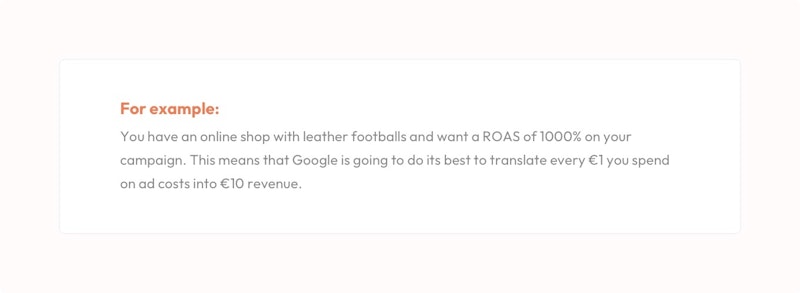
As with target CPA bidding, even if you don't have an online shop, you can manually enter the conversion value. So you can always use this bidding strategy.
Now that we've taught you all the ins and outs of Google Ads, let's move on to defining the strategy behind it.
7. Google Ads strategy
You will only ever run a successful Google Ads campaign if you think carefully about your strategy.
You need to set your goals and take stock of your opportunities in advance. Since it is also important to measure your results, in this chapter we will also dive into linking Google Analytics.
Set your goals
The basis of a good Google Ads campaign is setting a goal.
You can subsequently adjust all other settings (including bidding strategies) accordingly.
These are the five basic goals as defined by Google:
- Getting customers to perform an action on your website. The focus here is on increasing conversion
- Generate more traffic to your website. Here you focus on getting more clicks
- Increase brand awareness. Here you focus on as many impressions as possible (e.g. through Google's Display Network).
- Increase the number of interactions with your video ad. Instead of bidding per click, focus on bidding per view (CPV)
- Increase product or brand consideration. This can also be done per CPV, as well as through the Display Network
In short, it is important to be clear on what purpose you want the ad to serve.
In the following table, you will find the bidding strategies best suited to your different goals:
Target impression share bidding: Increase brand awareness/visibility
Maximize clicks bidding: More traffic on your website
- Maximize conversion bidding: More sales or leads (encouraging customers to show interest by signing up for a newsletter or filling in a contact form)
- Maximize conversion value bidding: Increase revenue
- Target CPA bidding: Healthy growth/better return on investment
- Target ROAS bidding: Better return on investment
Assess your opportunities
Besides setting goals, a good Google Ads strategy also involves gauging your opportunities.
After all, you have to set your own daily budget or bid, which Google will then use for you.
Your click share (see below) is an important guide for this.
Click share
Google describes click share as follows: "Click share is the estimated share of all achievable clicks that you have received, and is available only for Performance Max, Search, Shopping, and Hotel campaigns. You can use the click share metric to understand where you have potential to capture even more clicks. For example, if you received 60 clicks, and your click share is 60%, then it’s estimated that there were another 40 clicks that you could have received (...)."
Click share is an estimate that is determined based on all auctions that resulted in a display of your 'leather football' ad or auctions in which your ad was competitive but did not result in a display. This allows you to estimate in which areas you can generate even more clicks.
Measure your results
Setting a budget and determining a bid are both based on estimates.
Therefore, it is important to measure your results.
Only after measuring relevant data will you know how much that one ad is generating and whether it is a success.
An important tool for this is linking your Google Ads to Google Analytics. So don't forget to do this before setting up a Google Ads campaign.
ROI
ROI is the return on investment.
By measuring this, you can determine whether the money you spend on a specific Google Ads campaign is producing the desired results.
It is the ratio of net profit to cost based on your chosen objective.
This is how ROI can be determined: (revenue - cost of goods sold) / cost of goods sold
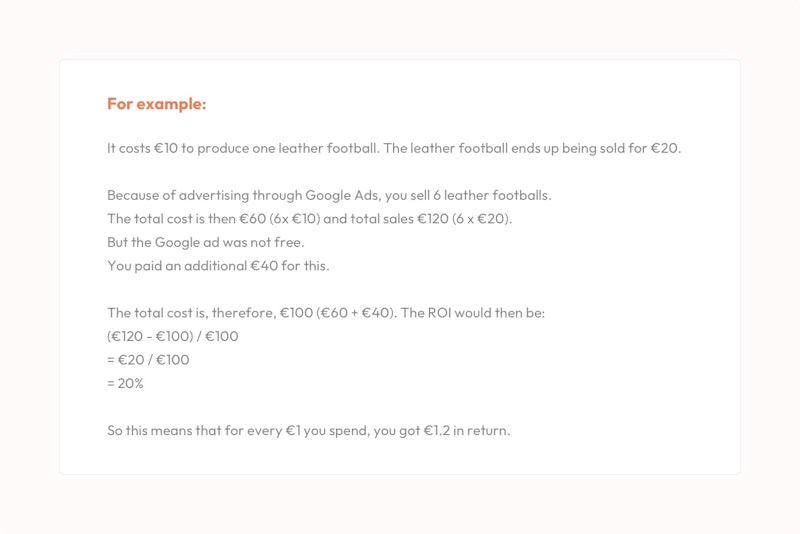
ROI is an important figure because it allows you to compare the effectiveness of different campaigns.
It gives you a good overview of which campaigns do better than others.Measuring brand awareness
Besides ROI, you can also measure brand awareness.
This is particularly useful when your Google Ads campaign has this specific goal.
Consider measuring:
- Impressions: this shows you how many potential customers saw your ad
- Customer engagement: you measure this using the CTR (click-through rate). This shows you whether your ads lead to more conversions, such as filling in a contact form or buying a product
- Reach & frequency: the number of people on Google that your campaign, for example about 'leather footballs', is exposed to. Frequency refers to how many times one user has seen your ad within a given period
Traffic to your website
Is your goal to maximize clicks to your website? Then it is useful to measure these results.
You can do this by looking at these factors:
- The number of clicks to your website + CTR: an important indicator of whether people on Google found your ad interesting enough to go to your landing page
- Keywords: Using Google Analytics, you can monitor how well your chosen keywords perform in your campaign. Should this performance be disappointing, you can choose to target your keyword differently
- Search terms: when you choose Broad Search, you can grab the Search Terms report to see which search terms your ad has activated. In this report, you will find relevant terms that you can add as new keywords to your next campaign. Are the terms in the report not relevant to your business? Then exclude these terms from your next campaign.
Before we conclude this guide, let's look ahead to the rest of 2023.
After all, Google, and therefore Google Ads, continues to evolve.
That is why we will walk you through some trends for 2023.
8. Ads trends 2023
These are the Ads trends for 2023:
- More automation: this will make advertising on Google even easier than it is now. For example, Google's recommendations will become so automated that they will be able to adjust ads so they generate more clicks or conversions, for example. The only downside to this is that Google Ads will become less transparent than it is now and you as a business owner cannot influence some aspects.
- Smart Shopping: the ad type Smart Shopping already exists, but will become even more popular in 2023. Automation is expected to take place here too, which means your product will automatically show up on YouTube, Gmail, Display Advertising, and Shopping Ads in the SERP. Sounds promising to us.
- Possible new bidding strategy: Target POAS. A new bidding strategy is rumored to arrive in 2023. One that focuses on profit instead of return on investment. The focus here is on the profitability of the product the ad is about. This will give you much more insight into how much an ad will bring you in terms of profit. We hope you will soon be able to use this Google Ads bidding strategy yourself.
9. Conclusion
You now know how to, from start to finish, set up a Google Ad or Ad campaign and how to measure your results. Adding the ad trends of 2023 to that, you can start using online advertising with Google Ads today!
3 reasons why you should start using Google Ads today
- Rank highly in Google's SERP so you not only increase your visibility but also your conversion rate
- With Google Ads you can increase your brand awareness in an accessible way
- With a good Ads strategy, your ad will reach your company's target audience
Keep this guide within reach and you’ll know exactly what to look out for when you are setting up a Google Ads campaign or ad.
As a final quick note: here are the five key points that are important when using Google Ads:
- Choose the right keywords and how you want to target them
- Determine the purpose of the ad
- Choose the ad type that suits your goal
- Choose a bidding strategy that fits your ad type and your goal
- Measure your results to help you adjust your existing campaigns
Now you know everything to get started with Google Ads, we're super curious to hear your thoughts on this guide.
What type of ad are you going to get started with right away and which bidding strategy do you prefer? Let us know by commenting below.
Maybe you have a question we haven't answered yet? Send us a message on social media. We always love to hear from you!
Need help from a digital agency? Do not hesitate to contact us or request our free analysis.
Request our free Google Ads analysis.
- A free analysis worth 4 to 6 hours of work
- Clear custom-made strategy
- 87% of the companies we analyze miss out on sales

